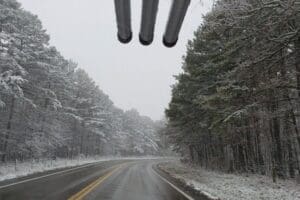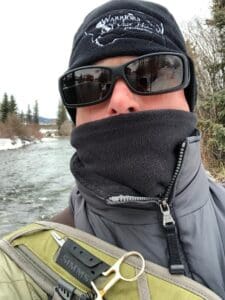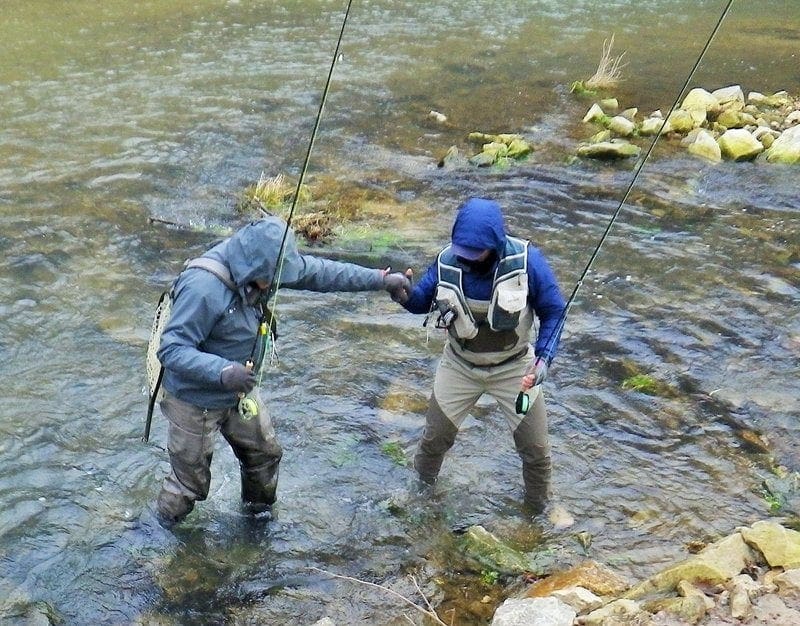Winter Fishing – Produces Great Results!!!

By now many of you have already cleaned and packed your fly-fishing gear away for the cold winter ahead. But why? The winter can be one of the best times to fly fish if you prepare yourself for the cold. Plus, the limited number of aquatic insect hatches that happen during the winter can help your selection of flies by limiting the number you will need to worry about. So, if your trout streams haven’t frozen over and you are willing to give it a go, let’s discuss a few things to make your trip to the waters in the winter as productive as they can be. Remember trout must eat and they are just as willing to take a fly in the winter as they are in the summer.
First things first, you must be properly dressed not only to enjoy the winter fishing but to also survive the harsh temperatures in something goes wrong. I can’t stress enough not to wear anything made of cotton. All winter survival schools teach that cotton is rotten or cotton kills. It is true. If you get wet or even fall in the cotton will absorb the water and maintain it making you colder. Hypothermia will set in quickly and now you are no longer fishing but surviving.

Here is just a short list of what to think about when you are preparing for winter fishing:
- Know your limits – don’t fish if it is too cold and ALWAYS fish with a buddy in the winter. Don’t go it alone.
- Wear Layers (top and bottoms) – fleece, wool, or the new athletic “wicky” type of under layers like the SonicDry base layer from Redington. That means no blue jeans under your waders!
- Wear wool socks – cold feet can ruin your day (remember no cotton)
- Wear a Balaclava or buff to cover your head and ears.
- Wear fingerless gloves – a good trick is to wear rubber surgical type gloves underneath. They will keep your hands dry and you can easily tie knots or flies on the hook with them on.
- Wear a good cold weather jacket that blocks the wind and is waterproof
- Buy some of those hand and toe warmers and have them handy in your jacket if needed
- And don’t forget the rest of your gear. Your rod guides will freeze up. Some guys use Chapstick on them or stuff made especially for guides. I just like sticking my rod in the water every so often to get the ice off (remember the water is warmer than the air or the stream would be frozen). Just try not to get your reel wet, if it freezes up there isn’t much you can do except using the water to unfreeze it – temporarily.
Well, now that you decided to go out in the freezing cold to fly fish what will your strategy be to catch a few trout. Let’s discuss what flies to think about using and why.
There are fewer hatches in the winter but that doesn’t mean that the aquatic insects aren’t active below the water surface. Two major hatches that can continue into the colder months are midges and BWOs. Plus, in some areas, you may even have a little black stonefly hatch. So, knowing this may help you limit your fly selection. Midges are prolific all year long and are an excellent food source for trout in the winter. BWOs can be out in numbers if the temperatures warm up in the afternoon hours. It’s probably best not to get to the stream too earlier. Once the temperatures are on the rise the insects will get more active – meaning the trout will become active in feeding. Flies like zebra midges, primrose & pearl midges, red midges, Griffith’s Gnats, Barr’s Emergers, juju baetis, and RS2s are all good flies to start with. I like fishing a tandem rig and may add an attractor fly to the mix like a small copper john. I usually find that smaller is better in the winter. If I see trout rising to the emergers then I like swinging a soft hackle past their noses.
The presentation is important because the trout may not be on the move like in the summer and higher water levels. The winter usually comes with clear waters and low flow which make the trout a little more skittish and wilier. They tend to find their hiding places and stay close, so you will have to get your flies closer to the feeding trout and be stealthy while doing it. Look for undercut banks, deep holes, boulders and wood structure for your trout. Small indicators or tight line techniques, hopefully, won’t spook the trout during your delivery. Just be wary that with small flies the trout can take them in and spit them out in seconds so ANY slight change in movement of your indicator or in your sighter (if tight lining) – set the hook!
Don’t limit yourself to just midges and BWOs though for there are other food sources that the winter trout will be looking for. Scuds, sow bugs and aquatic worms will be in many of the streams we fish especially the tailwaters. You might be able to convince a winter trout to chase a minnow or leech imitation too. So, make sure you carry a few of these flies to the water.
Winter fishing can bring much success in your hunt for the big trout. Just remember to fish with a buddy, dress properly, bring the correct flies for the season, be stealthy, look for the trout in their hiding places and have fun.

